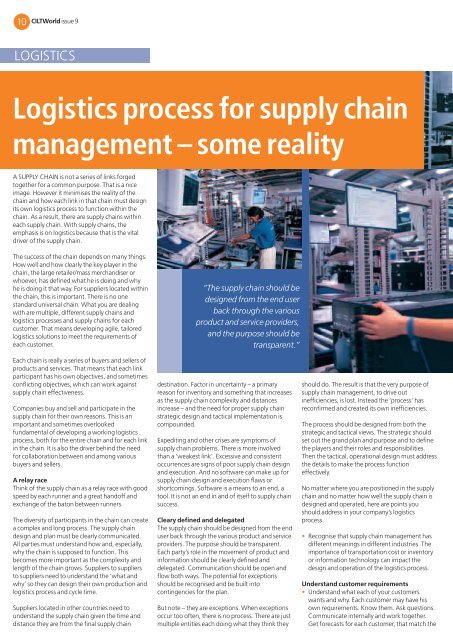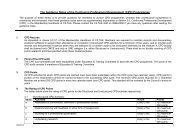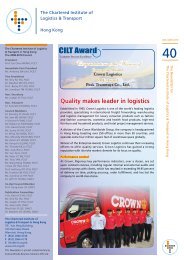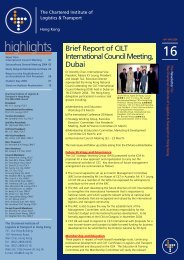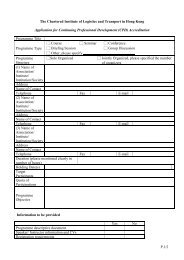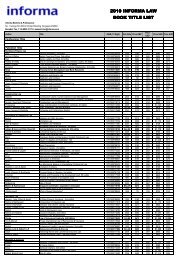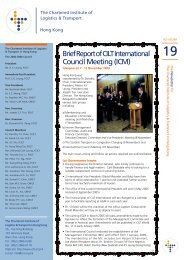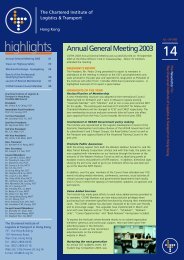CIT WORLD 8 TEMPLATE - The Chartered Institute of Logistics and ...
CIT WORLD 8 TEMPLATE - The Chartered Institute of Logistics and ...
CIT WORLD 8 TEMPLATE - The Chartered Institute of Logistics and ...
Create successful ePaper yourself
Turn your PDF publications into a flip-book with our unique Google optimized e-Paper software.
10<br />
CILTWorld issue 9<br />
LOGISTICS<br />
<strong>Logistics</strong> process for supply chain<br />
management – some reality<br />
A SUPPLY CHAIN is not a series <strong>of</strong> links forged<br />
together for a common purpose. That is a nice<br />
image. However it minimises the reality <strong>of</strong> the<br />
chain <strong>and</strong> how each link in that chain must design<br />
its own logistics process to function within the<br />
chain. As a result, there are supply chains within<br />
each supply chain. With supply chains, the<br />
emphasis is on logistics because that is the vital<br />
driver <strong>of</strong> the supply chain.<br />
<strong>The</strong> success <strong>of</strong> the chain depends on many things.<br />
How well <strong>and</strong> how clearly the key player in the<br />
chain, the large retailer/mass merch<strong>and</strong>iser or<br />
whoever, has defined what he is doing <strong>and</strong> why<br />
he is doing it that way. For suppliers located within<br />
the chain, this is important. <strong>The</strong>re is no one<br />
st<strong>and</strong>ard universal chain. What you are dealing<br />
with are multiple, different supply chains <strong>and</strong><br />
logistics processes <strong>and</strong> supply chains for each<br />
customer. That means developing agile, tailored<br />
logistics solutions to meet the requirements <strong>of</strong><br />
each customer.<br />
Each chain is really a series <strong>of</strong> buyers <strong>and</strong> sellers <strong>of</strong><br />
products <strong>and</strong> services. That means that each link<br />
participant has his own objectives, <strong>and</strong> sometimes<br />
conflicting objectives, which can work against<br />
supply chain effectiveness.<br />
Companies buy <strong>and</strong> sell <strong>and</strong> participate in the<br />
supply chain for their own reasons. This is an<br />
important <strong>and</strong> sometimes overlooked<br />
fundamental <strong>of</strong> developing a working logistics<br />
process, both for the entire chain <strong>and</strong> for each link<br />
in the chain. It is also the driver behind the need<br />
for collaboration between <strong>and</strong> among various<br />
buyers <strong>and</strong> sellers.<br />
A relay race<br />
Think <strong>of</strong> the supply chain as a relay race with good<br />
speed by each runner <strong>and</strong> a great h<strong>and</strong><strong>of</strong>f <strong>and</strong><br />
exchange <strong>of</strong> the baton between runners.<br />
<strong>The</strong> diversity <strong>of</strong> participants in the chain can create<br />
a complex <strong>and</strong> long process. <strong>The</strong> supply chain<br />
design <strong>and</strong> plan must be clearly communicated.<br />
All parties must underst<strong>and</strong> how <strong>and</strong>, especially,<br />
why the chain is supposed to function. This<br />
becomes more important as the complexity <strong>and</strong><br />
length <strong>of</strong> the chain grows. Suppliers to suppliers<br />
to suppliers need to underst<strong>and</strong> the ‘what <strong>and</strong><br />
why’ so they can design their own production <strong>and</strong><br />
logistics process <strong>and</strong> cycle time.<br />
Suppliers located in other countries need to<br />
underst<strong>and</strong> the supply chain given the time <strong>and</strong><br />
distance they are from the final supply chain<br />
“<strong>The</strong> supply chain should be<br />
designed from the end user<br />
back through the various<br />
product <strong>and</strong> service providers,<br />
<strong>and</strong> the purpose should be<br />
transparent.”<br />
destination. Factor in uncertainty – a primary<br />
reason for inventory <strong>and</strong> something that increases<br />
as the supply chain complexity <strong>and</strong> distances<br />
increase – <strong>and</strong> the need for proper supply chain<br />
strategic design <strong>and</strong> tactical implementation is<br />
compounded.<br />
Expediting <strong>and</strong> other crises are symptoms <strong>of</strong><br />
supply chain problems. <strong>The</strong>re is more involved<br />
than a ‘weakest link’. Excessive <strong>and</strong> consistent<br />
occurrences are signs <strong>of</strong> poor supply chain design<br />
<strong>and</strong> execution. And no s<strong>of</strong>tware can make up for<br />
supply chain design <strong>and</strong> execution flaws or<br />
shortcomings. S<strong>of</strong>tware is a means to an end, a<br />
tool. It is not an end in <strong>and</strong> <strong>of</strong> itself to supply chain<br />
success.<br />
Cleary defined <strong>and</strong> delegated<br />
<strong>The</strong> supply chain should be designed from the end<br />
user back through the various product <strong>and</strong> service<br />
providers. <strong>The</strong> purpose should be transparent.<br />
Each party’s role in the movement <strong>of</strong> product <strong>and</strong><br />
information should be clearly defined <strong>and</strong><br />
delegated. Communication should be open <strong>and</strong><br />
flow both ways. <strong>The</strong> potential for exceptions<br />
should be recognised <strong>and</strong> be built into<br />
contingencies for the plan.<br />
But note – they are exceptions. When exceptions<br />
occur too <strong>of</strong>ten, there is no process. <strong>The</strong>re are just<br />
multiple entities each doing what they think they<br />
should do. <strong>The</strong> result is that the very purpose <strong>of</strong><br />
supply chain management, to drive out<br />
inefficiencies, is lost. Instead the ‘process’ has<br />
reconfirmed <strong>and</strong> created its own inefficiencies.<br />
<strong>The</strong> process should be designed from both the<br />
strategic <strong>and</strong> tactical views. <strong>The</strong> strategic should<br />
set out the gr<strong>and</strong> plan <strong>and</strong> purpose <strong>and</strong> to define<br />
the players <strong>and</strong> their roles <strong>and</strong> responsibilities.<br />
<strong>The</strong>n the tactical, operational design must address<br />
the details to make the process function<br />
effectively.<br />
No matter where you are positioned in the supply<br />
chain <strong>and</strong> no matter how well the supply chain is<br />
designed <strong>and</strong> operated, here are points you<br />
should address in your company’s logistics<br />
process.<br />
• Recognise that supply chain management has<br />
different meanings in different industries. <strong>The</strong><br />
importance <strong>of</strong> transportation cost or inventory<br />
or information technology can impact the<br />
design <strong>and</strong> operation <strong>of</strong> the logistics process.<br />
Underst<strong>and</strong> customer requirements<br />
• Underst<strong>and</strong> what each <strong>of</strong> your customers<br />
wants <strong>and</strong> why. Each customer may have his<br />
own requirements. Know them. Ask questions.<br />
Communicate internally <strong>and</strong> work together.<br />
Get forecasts for each customer, that match the


